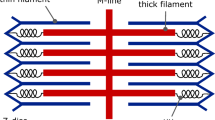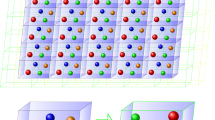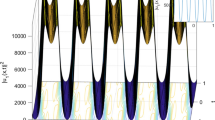Abstract
Owing to its viscoelastic nature, axon exhibits a stress rate-dependent me- chanical behavior. An extended tension-shear chain model with Kelvin-Voigt viscoelas- ticity is developed to illustrate the micromechanical behavior of the axon under dynamic torsional conditions. Theoretical closed-form expressions are derived to predict the de- formation, stress transfer, and failure mechanism between microtubule (MT) and tau protein while the axon is sheared dynamically. The results obtained from the present an- alytical solutions demonstrate how the MT-tau interface length, spacing between the tau proteins, and loading rate affect the mechanical properties of axon. Moreover, it is found that the MTs are more prone to rupture due to the contributions from the viscoelastic effects. Under the torsional force, the MTs are so long that the stress concentrates at the loaded end where axonal MTs will break. This MT-tau protein dynamics model can help to understand the underlying pathology and molecular mechanisms of axonal injury. Additionally, the emphasis of this paper is on the micromechanical behavior of axon, whereas this theoretical model can be equally applicable to other soft or hard tissues, owning the similar fibrous structure.
Similar content being viewed by others
References
Hay, J., Johnson, V. E., Smith, D. H., and Stewart, W. Chronic traumatic encephalopathy: the neuropathological legacy of traumatic brain injury. Annual Review of Pathology, 11, 21–45 (2016)
Tagliaferri, F., Compagnone, C., Korsic, M., Servadei, F., and Kraus, J. A systematic review of brain injury epidemiology in Europe. Acta Neurochirurgica, 148, 255–268 (2006)
Lazarus, C., Soheilypour, M., and Mofrad, M. R. Torsional behavior of axonal microtubule bundles. Biophysical Journal, 109, 231–239 (2015)
Lang, G. E., Waters, S. L., Vella, D., and Goriely, A. Axonal buckling following stretch injury. Journal of Elasticity, 11, 1–18 (2017)
Emilia, P., Grzegorz, W., Anna, S. O., Patryk, J., and Elżbieta, S. The comparison of the value of CT imaging and selected MRI sequences (including DWI) in the evaluation of axonal injuries. Polish Journal of Radiology, 75, 13–17 (2010)
Wright, R. M. and Ramesh, K. T. An axonal strain injury criterion for traumatic brain injury. Biomechanics and Modeling in Mechanobiology, 11, 245–260 (2012)
Donald, C. L. M., Dikranian, K., Song, S. K., Bayly, P. V., Holtzman, D. M., and Brody, D. L. Detection of traumatic axonal injury with diffusion tensor imaging in a mouse model of traumatic brain injury. Experimental Neurology, 205, 116–131 (2007)
Bennett, R. E., Donald, C. L. M., and Brody, D. L. Diffusion tensor imaging detects axonal injury in a mouse model of repetitive closed-skull traumatic brain injury. Neuroscience Letters, 513, 160–165 (2012)
Conde, C. and Cáceres, A. Microtubule assembly, organization and dynamics in axons and dendrites. Nature Reviews Neuroscience, 10, 319–332 (2009)
Pampaloni, F., Lattanzi, G., Jonás, A., Surrey, T., Frey, E., and Florin, E. L. Thermal fluctuations of grafted microtubules provide evidence of a length-dependent persistence length. Proceedings of the National Academy of Sciences, 103, 10248–10253 (2006)
Chen, J., Kanai, Y., Cowan, N. J., and Hirokawa, N. Projection domains of MAP2 and tau determine spacings between microtubules in dendrites and axons. nature, 360, 674–677 (1992)
Ahmadzadeh, H., Smith, D. H., and Shenoy, V. B. Viscoelasticity of tau proteins leads to strain rate-dependent breaking of microtubules during axonal stretch injury: predictions from a mathematical model. Biophysical Journal, 106, 1123–1133 (2014)
Goldstein, L. S. and Yang, Z. Microtubule-based transport systems in neurons: the roles of kinesins and dyneins. Annual Review of Neuroscience, 23, 39–71 (2000)
Lu, W. and Gelfand, V. I. Moonlighting motors: kinesin, dynein, and cell polarity. Trends in Cell Biology, 27, 505–514 (2017)
Schaedel, L., John, K., Gaillard, J., Nachury, M. V., Blanchoin, L., and Théry, M. Microtubules self-repair in response to mechanical stress. Nature Materials, 14, 1156–1163 (2015)
Rooij, R., Miller, K. E., and Kuhl, E. Modeling molecular mechanisms in the axon. Computational Mechanics, 59, 1–15 (2016)
Kis, A., Kasas, S., Babić, B., Kulik, A. J., Benôit, W., Briggs, G. A. D., SchÖnenberger, C., Catsicas, S., and Forró, L. Nanomechanics of microtubules. Physical Review Letters, 89, 248101 (2002)
Reeves, A. G. and Swenson, R. S. Chapter 29: cranial and spinal trauma. Disorders of the Nervous System, a Primer. http://www.dartmouth.edu/~dons/. (2004)
Meaney, D. F., Smith, D. H., Shreiber, D. I., Bain, A. C., Miller, R. T., Ross, D. T., and Gennarelli, T. A. Biomechanical analysis of experimental diffuse axonal injury. Journal of Neurotrauma, 12, 689–694 (1995)
Gennarelli, T. A., Thibault, L. E., Adams, J. H., Graham, D. I., Thompson, C. J., and Marcincin, R. P. Diffuse axonal injury and traumatic coma in the primate. Annals of Neurology, 12, 564–574 (1982)
Thibault, L., Gennarelli, T., and Margulies, S. S. The strain dependent pathophysiological consequences of inertial loading on central nervous system tissue. International Conference on the Biomechanics of Impacts, Bron, France (1990)
Ivancevic, V. G. New mechanics of traumatic brain injury. Cognitive Neurodynamics, 3, 281–293 (2009)
Zhang, L., Yang, K. H., and King, A. I. A proposed injury threshold for mild traumatic brain injury. Transactions-American Society of Mechanical Engineers Journal of Biomechanical Engineering, 126, 226–236 (2004)
Kučera, O., Havelka, D., and Cifra, M. Vibrations of microtubules: physics that has not met biology yet. Wave Motion, 72, 13–22 (2016)
Zhang, J. and Wang, C. Boundary condition-selective length dependence of the flexural rigidity of microtubules. Physics Letters A, 381, 2167–2173 (2017)
Zhang, J. and Wang, C. Molecular structural mechanics model for the mechanical properties of microtubules. Biomechanics and Modeling in Mechanobiology, 13, 1175–1184 (2014)
Yasuda, R., Miyata, H., Jr, and Kinosita, K. Direct measurement of the torsional rigidity of single actin filaments. Journal of Molecular Biology, 263, 227–236 (1996)
Kikumoto, M., Kurachi, M., Tosa, V., and Tashiro, H. Flexural rigidity of individual microtubules measured by a buckling force with optical traps. Biophysical Journal, 90, 1687–1696 (2006)
Tsuda, Y., Yasutake, H., Ishijima, A., and Yanagida, T. Torsional rigidity of single actin filaments and actin–actin bond breaking force under torsion measured directly by in vitro micromanipulation. Proceedings of the National Academy of Sciences, 93, 12937–12942 (1996)
Yi, L., Chang, T., and Ru, C. Buckling of microtubules under bending and torsion. Journal of Applied Physics, 103, 103516 (2008)
Che lminiak, P., Dixon, J., and Tuszyński, J. Torsional elastic deformations of microtubules within continuous sheet model. The European Physical Journal E, 31, 215–227 (2010)
Demir, C. and Civalek, Ö. Torsional and longitudinal frequency and wave response of microtubules based on the nonlocal continuum and nonlocal discrete models. Applied Mathematical Modelling, 37, 9355–9367 (2013)
Johnson, V. E., Weber, M. T., Xiao, R., Cullen, D. K., Meaney, D. F., Stewart, W., and Smith, D. H. Mechanical disruption of the blood-brain barrier following experimental concussion. Acta Neuropathologica (2018) https://doi.org/10.1007/s00401-018-1824-0
Tangschomer, M. D., Patel, A. R., Baas, P. W., and Smith, D. H. Mechanical breaking of microtubules in axons during dynamic stretch injury underlies delayed elasticity, microtubule disassembly, and axon degeneration. The FASEB Journal, 24, 1401–1410 (2010)
Ahmadzadeh, H., Smith, D. H., and Shenoy, V. B. Mechanical effects of dynamic binding between tau proteins on microtubules during axonal injury. Biophysical Journal, 109, 2328–2337 (2015)
Gao, H., Ji, B., J¨ager, I., Arzt, E., and Fratzl, P. Materials become insensitive to flaws at nanoscale: lessons from nature. Proceedings of the National Academy of Sciences, 100, 5597–5600 (2003)
Gao, H., Ji, B., Buehler, M. J., and Yao, H. Flaw tolerant nanostructures of biological materials. Mechanics of the 21st Century, Springer, Dordrecht, 131–138 (2005)
Singh, A., Kallakuri, S., Chen, C., and Cavanaugh, J. M. Structural and functional changes in nerve roots due to tension at various strains and strain rates: an in-vivo study. Journal of Neurotrauma, 26, 627–640 (2009)
Shamloo, A., Manuchehrfar, F., and Rafii-Tabar, H. A viscoelastic model for axonal microtubule rupture. Journal of Biomechanics, 48, 1241–1247 (2015)
Cloots, R. J. H., van Dommelen, J. A. W., Kleiven, S., and Geers, M. G. D. Multi-scale mechanics of traumatic brain injury: predicting axonal strains from head loads. Biomechanics and Modeling in Mechanobiology, 12, 1–14 (2013)
Wegmann, S., Schöler, J., Bippes, C. A., Mandelkow, E., and Muller, D. J. Competing interactions stabilize pro-and anti-aggregant conformations of human tau. Journal of Biological Chemistry, 286, 20512–20524 (2011)
Fadić, R., Vergara, J., and Alvarez, J. Microtubules and caliber of central and peripheral processes of sensory axons. Journal of Comparative Neurology, 236, 258–264 (1985)
Peter, S. J. and Mofrad, M. R. Computational modeling of axonal microtubule bundles under tension. Biophysical Journal, 102, 749–757 (2012)
Huang, G., Mai, Y., and Ru, C. Surface deflection of a microtubule loaded by a concentrated radial force. Nanotechnology, 19, 125101 (2008)
Spillantini, M. G. and Goedert, M. Tau protein pathology in neurodegenerative diseases. Trends in Neurosciences, 21, 428–433 (1998)
Hirokawa, N., Shiomura, Y., and Okabe, S. Tau proteins: the molecular structure and mode of binding on microtubules. The Journal of Cell Biology, 107, 1449–1459 (1988)
Kawakami, M., Byrne, K., Brockwell, D. J., Radford, S. E., and Smith, D. A. Viscoelastic study of the mechanical unfolding of a protein by AFM. Biophysical Journal, 91, L16–L18 (2006)
Bell, G. I. Models for the specific adhesion of cells to cells. Science, 200, 618–627 (1978)
Rosenberg, K. J., Ross, J. L., Feinstein, H. E., Feinstein, S. C., and Israelachvili, J. Complementary dimerization of microtubule-associated tau protein: implications for microtubule bundling and tau-mediated pathogenesis. Proceedings of the National Academy of Sciences, 105, 7445–7450 (2008)
Goriely, A., Geers, M. G. D., Holzapfel, G. A., Jayamohan, J., Jérusalem, A., Sivaloganathan, S., Squier, W., van Dommelen, J. A. W., Waters, S., and Kuhl, E. Mechanics of the brain: perspectives, challenges, and opportunities. Biomechanics and Modeling in Mechanobiology, 14, 931–965 (2015)
Wu, J., Yuan, H., Li, L., Fan, K., Qian, S., and Li, B. Viscoelastic shear lag model to predict the micromechanical behavior of tendon under dynamic tensile loading. Journal of Theoretical Biology, 437, 202–213 (2018)
Soheilypour, M., Peyro, M., Peter, S. J., and Mofrad M. R. K. Buckling behavior of individual and bundled microtubules. Biophysical Journal, 108, 1718–1726 (2015)
Aumeier, C., Schaedel, L., Gaillard, J., John, K., Blanchoin, L., and Théry, M. Self-repair promotes microtubule rescue. Nature Cell Biology, 18, 1054–1064 (2016)
Mckee, A. C., Cantu, R. C., Nowinski, C. J., Hedleywhyte, E. T., Gavett, B. E., Budson, A. E., Santini, V. E., Lee, H. S., Kubilus, C. A., and Stern, R. A. Chronic traumatic encephalopathy in athletes: progressive tauopathy after repetitive head injury. Journal of Neuropathology and Experimental Neurology, 68, 709–735 (2009)
Vandenbedem, H. and Kuhl, E. Tau-ism: the Yin and Yang of microtubule sliding, detachment, and rupture. Biophysical Journal, 109, 2215–2217 (2015)
Author information
Authors and Affiliations
Corresponding author
Additional information
Project supported by the National Natural Science Foundation of China (No. 11032005), the Major Project of Department of Science and Technology of Guizhou Province (No. 2014-6024), and the Academician Workstation of Department of Science and Technology of Guizhou Province (No. 2015-4004)
Rights and permissions
About this article
Cite this article
Wu, J.Y., Yuan, H. & Li, L.Y. Mathematical modelling of axonal microtubule bundles under dynamic torsion. Appl. Math. Mech.-Engl. Ed. 39, 829–844 (2018). https://doi.org/10.1007/s10483-018-2335-9
Received:
Revised:
Published:
Issue Date:
DOI: https://doi.org/10.1007/s10483-018-2335-9
Keywords
- torsion
- biocomposite
- diffuse axonal injury (DAI)
- Kelvin-Voigt viscoelas- tic model
- dynamic response
- tension-shear chain model




